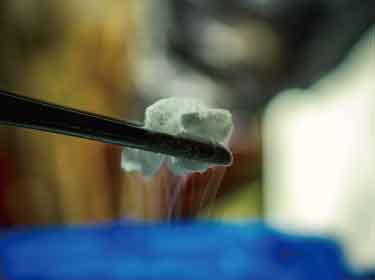Written by Roshini Beenukumar, PhD
Cryopreservation is a valuable technique for long-term storage of biological materials for research and clinical purposes. Cryoprotective agents (CPAs) are usually added during freezing to protect the cells from damage. However, it is not ideal because of their toxicity and other side effects. In a study published in PNAS, a team of scientists from Shinshu University, Japan, demonstrated a novel technique, using which they froze animal cells without a CPA. This is the first time that cryopreservation was achieved without a cryoprotectant.
Why use cryoprotectants?
Cryoprotectants such as glycerol, propylene glycol, dimethyl sulfoxide (DMSO) are chemical compounds that protect cells from damage during free-thaw. During cryopreservation, freezing of water damages cells in two different ways:
- The shape of cells gets distorted by ice crystals causing mechanical damage.
- The solutes in the unfrozen water get concentrated causing chemical and osmotic damage.
As ice crystals form, cells get packed into small pockets of unfrozen liquid. This is where cryoprotectants come into play – these cell-packed pockets are larger in the presence of cryoprotectants which prevents damage from both mechanical and chemical and osmotic damage. CPAs work even better during vitrification, a process by which ice crystal formation is avoided by rapid cooling. However, vitrification is usually done in higher concentrations of CPA, risking toxicity.
Freezing cells using cryoprotectants is not an ideal solution
CPAs exhibit cytotoxicity and other negative side effects on the cellular state. This is particularly crucial in a clinical scenario; DMSO, a common CPA, has been reported to induce serious adverse reactions in certain patients. Certain cell types such as embryonic carcinoma cell lines and pluripotent stem-cell lines are more susceptible to damage by DMSO as it could influence their key properties such as stemness and differentiation. Other CPAs such as trehalose are less harmful compared to DMSO. However, trehalose transporters must be transgenically expressed on the cell membrane to make them permeable to trehalose.

Hence, the ideal solution is to cryopreserve cells without CPAs. Complete vitrification by ultra-rapid cooling is theoretically possible and the critical cooling rates (CCRs) for vitrification of pure water have been calculated. However, complete vitrification is not experimentally possible for cells. Luckily, cells can tolerate small ice crystals or nanocrystals. The authors, therefore hypothesized that CPA-free cryopreservation should be possible by ultra-rapid freezing where only nano-crystallized ice formation occurs.
‘Superflash freezing’ combined with inkjet cell printing to freeze cells without a CPA
This new technique for cellular cryopreservation dubbed ‘superflash freezing’ combines ultrarapid cooling with inkjet cell printing. Dr. Yoshitake Akiyama, Ph.D., the corresponding author of the study and Associate Professor of Department of Mechanical Engineering and Robotics, Faculty of Textile Science and Technology, Shinshu University explains "Ultrarapid cooling is much faster than the cooling rate that is typically used in cryopreservation. We call it superflash freezing, and it can almost vitrify and cryopreserve living cells without any cryoprotectant agent."

Using the inkjet cell printing technique, the researchers were able to achieve the critical cooling rate for CPA-free ultrarapid freezing – 10,000ºC per second. They printed very small cell-containing droplets onto glass substrates pre-cooled with liquid nitrogen. The technique they used called solid-surface vitrification cools the droplets not directly by liquid nitrogen, but by the substrate pre-cooled by liquid nitrogen. Near vitrification of the droplets was confirmed independently by two methods – Raman spectroscopy measurements and images using an ultra-high-speed video camera.
The viability of mouse fibroblast 3T3 cells frozen by this technique was studied under various conditions. After experimenting with different droplet sizes, they found that the survival rate for 40 pL droplets on thick substrates (thickness: 150 μm) was comparable to that of the conventional method. Reducing the substrate thickness to 5 μm increased the cell viability by another 5%.
What type of cells is compatible with superflash cooling?
Apart from mouse fibroblast 3T3 cells, the researched applied superflash freezing to two other cell types – mouse myoblast C2C12 cells and rat mesenchymal stem cells. The viability of both cell types after freezing 40 pL droplets on a thick glass substrate was comparable to conventional methods. The effect of superflash freezing on rat mesenchymal stem cells was further characterized. Certain cell surface epitopes expressed by these cells such as CD146, CD73 were still expressed after freeze-thaw. The researchers plan to expand this technique to more cell types including pluripotent stem cells.
Conclusion
Cryopreservation has become a routine procedure for the long-term storage of cells. Conventionally, cryopreservation is achieved by adding at least one CPA to maintain their viability after thaw. However, CPAs, particularly at higher concentration can be toxic to the cells and could lead to other side effects. This new technique developed by Shinshu University researchers proves that cryopreservation without CPA is possible. Near-vitrification of cells is achieved by ultrarapid cooling and inkjet cell printing. They also demonstrated that multiple cell types are compatible with this technique.
Future directions
The researchers plan to expand this method to make it compatible with a lot more cell types and applications. Superflash freezing could be applied for cryofixation – a technique used for the sample preparation in cellular imaging techniques such as soft X-ray tomography, high-aperture cryolight microscopy. Prof. Dr. Akiyama says, "We plan to use our method to cryopreserve other cells including pluripotent stem cells, whose properties such as stemness and differentiation are known to be susceptible to CPAs. Furthermore, we believe that our method might be suitable for cells such as hemocytes that cannot be stored by a conventional cryopreservation method."
"Stay informed with the latest news from PHCbi”

Reference
1. A new way to ‘freeze’ cells promises to transform the common cell-freezing practice. EurekAlert! https://www.eurekalert.org/pub_releases/2019-04/su-anw042419.php.
2. Akiyama, Y., Shinose, M., Watanabe, H., Yamada, S. & Kanda, Y. Cryoprotectant-free cryopreservation of mammalian cells by superflash freezing. Proc. Natl. Acad. Sci. 116, 7738–7743 (2019).
3. How-Cryoprotectants-Work. Cryonics/Third Quarter 2007. https://www.cryonics.com/Library/pdfs/How-Cryoprotectants-Work.pdf
4. Best, B. P. Cryoprotectant Toxicity: Facts, Issues, and Questions. Rejuvenation Res. 18, 422–436 (2015).
About PHCbi
The “bi” part of our new brand PHCbi is not only a shortened form of the word “biomedical” but also represents both our strength and philosophy as an abbreviation of “biomedical innovation.”
Since the launch of our first Pharmaceutical Refrigerator model in 1966, we have taken advantage of this technology to create exceptional medical and laboratory products and services with a high degree of quality and reliability. We have worked to meet the expectations of customers in the medical and life science fields under both the Sanyo and Panasonic brands. See more detail from "About PHCbi". Find PHCbi's customer case study in the world.